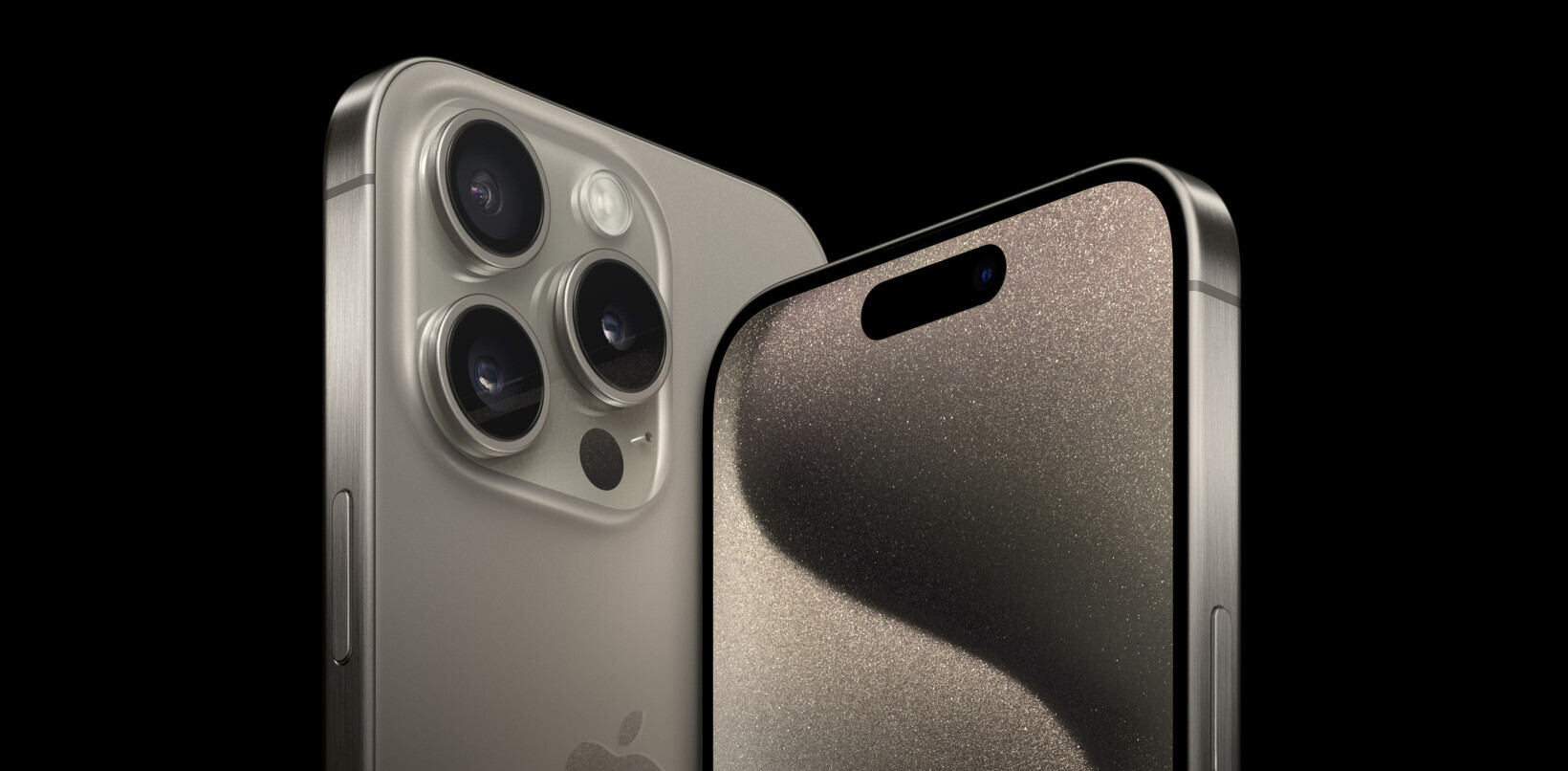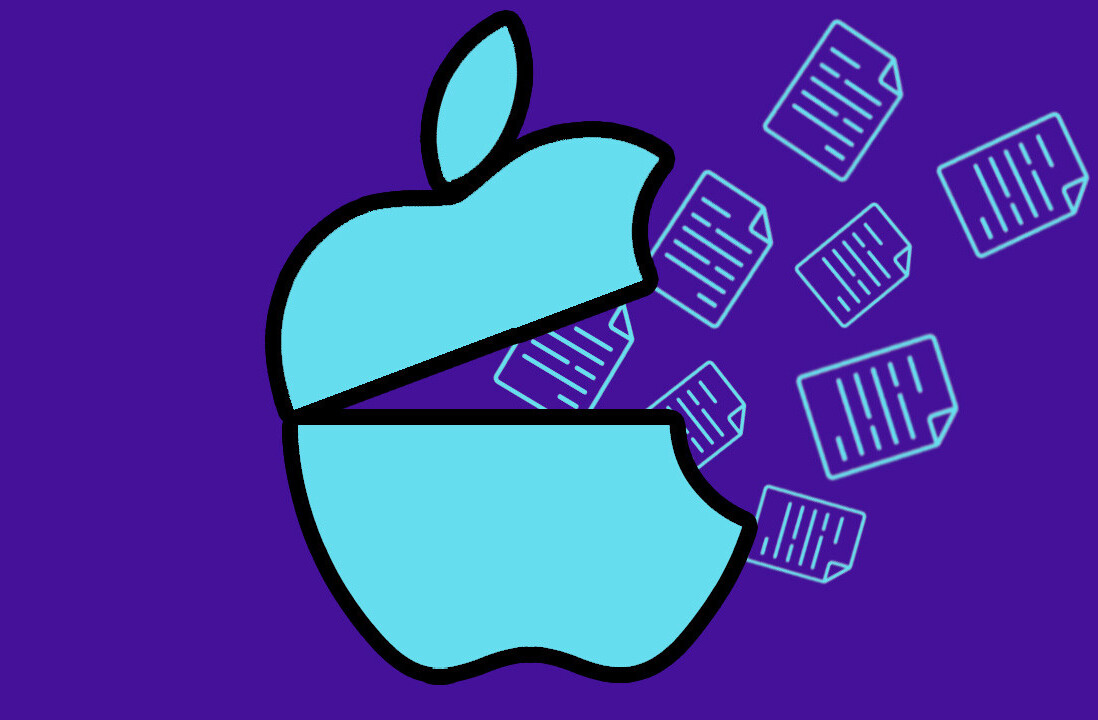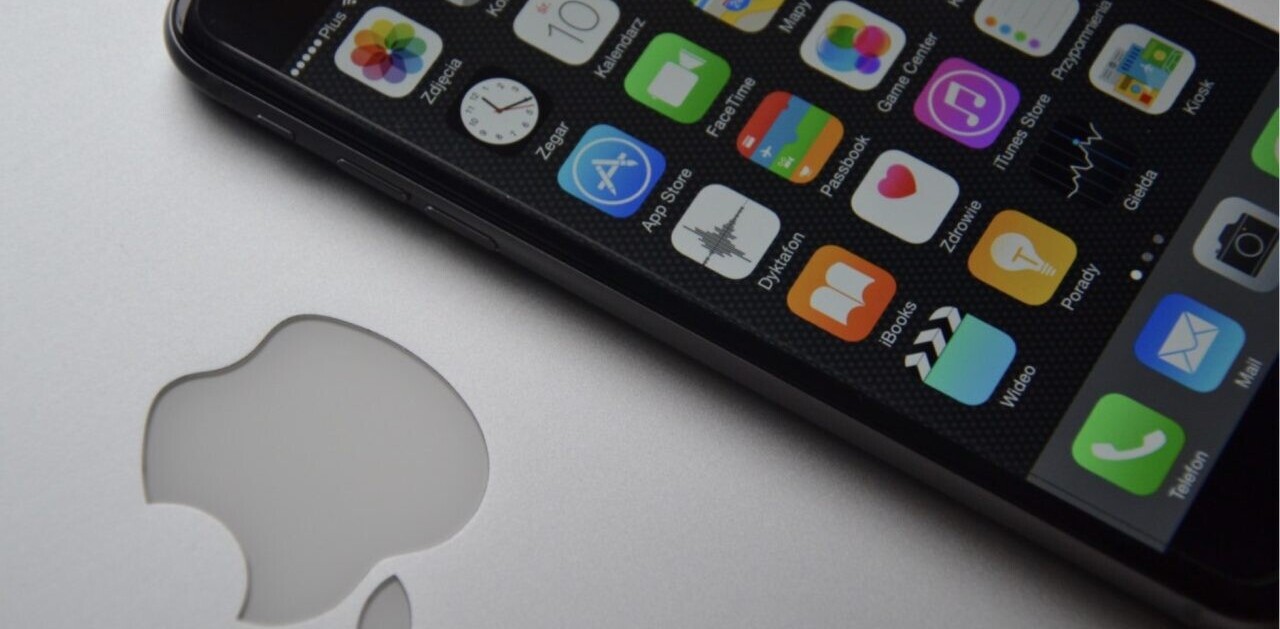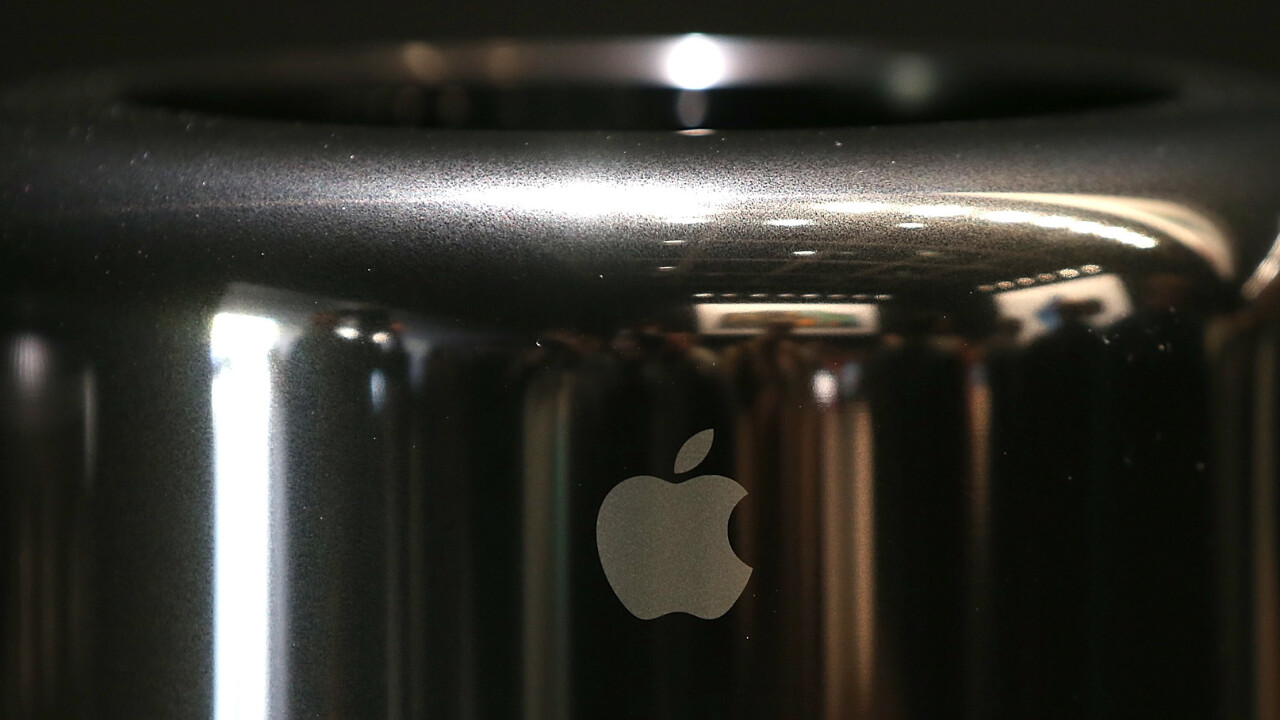
Thirty may be the new 20 for yuppies, but when it comes to computing, three decades is several lifetimes. When you think about the Mac’s multiple architecture changes and software transitions throughout the years, the long-standing feline theme on OS X actually seems rather fitting.

After marking the history of the Mac and its impact on personal computing last week for the 30th anniversary, we’re taking a look at its future. We spoke with some of the original team members of the Macintosh project and two long-time Apple analysts to get their thoughts on the fate of the Mac.
Macworld’s Jason Snell recently asked some of Apple’s top executives to reflect on the future of the Mac. Phil Schiller, the firm’s Senior Vice President of worldwide marketing, said:
There is a super-important role [for the Mac] that will always be. We don’t see an end to that role. There’s a role for the Mac as far as our eye can see. A role in conjunction with smartphones and tablets, that allows you to make the choice of what you want to use. Our view is, the Mac keeps going forever, because the differences it brings are really valuable.
Apple, at least publicly, remains supremely confident in the long-term future of the Mac, and we’d expect nothing less from a marketing executive. However, the world is transitioning to mobile computing, and the Mac will have to adapt.
Steve Jobs predicted in 2010 shortly after the release of the original iPad that PCs would transition to specialized tools for a small subset of the population. Speaking at AllThingsD’s D8 conference, he said:
PCs are going to be like trucks. They’re still going to be around, they’re still going to have a lot of value, but they’re going to be used by one out of X people. … I think that we’re embarked on that. Is the next step the iPad? Who knows? Will it happen next year or five years from now or seven years from now? Who knows? But I think we’re headed in that direction.
In its most recent quarter, Apple still managed 19 percent year-over-year growth in its Mac division. However, even if the company manages to continue to grow Mac market share, it’s doing so in a shrinking market. Gartner recently estimated that PC shipments fell 6.9 percent year-over-year in the fourth quarter of 2013.
By comparison, Apple’s iPad sales were up 13.5 percent year-over-year to 26 million during the same period. That’s almost as many shipments as the estimated 28.4 million PCs shipped by both Lenovo and HP, the top two PC makers, during Q4 2013.
Apple correctly predicted, and pioneered, the arrival of the smartphone and the tablet categories over the past few years. But as the PC industry contracts, it has to figure out what to do with the Mac.
Next up: ARM? | View on one page
ARM?
One of the biggest questions about the future of the Mac is whether it will remain on Intel indefinitely or switch over to the ARM architecture that powers Apple’s iOS devices.
When we spoke to original Mac team member Andy Hertzfeld about the future of the Mac, he speculated that a switch to ARM is coming.
The Mac certainly has a future, but clearly it no longer is at the forefront of technology, innovation, or evolution. It’s been superseded. Apple is the company that superseded it with the iOS platform, the iPhone and the iPad. Especially the iPad, it’s taking more and more and more of the user’s time away from the Macintosh platform.
Soon, it’s obvious, might even be in 2014, it will merge with iOS. It won’t make sense to maintain two once the newer thing gets powerful enough, and it’s already there with a 64-bit processor. Pretty soon you’ll see Macs and iPads come together, and then what will you call it?
Hertzfeld noted that computing has followed an obvious trend going back to the days of mainframes where it got progressively smaller, more personal and intimate. The smartphone is a prime example of that, and the coming tide of wearables is the next step.
“Ten years is an epoch in the technology industry. The Macintosh in the course of its history didn’t stick with a processor architecture more than 10 years,” Hertzfeld continued, citing the company’s shifts from Motorola 68k to PowerPC and then to Intel.
Tim Bajarin, President at tech research firm Creative Strategies, on the other hand, believes Apple will keep the two operating systems separate.
“The Mac/OS X is the power OS. iOS is the evolutionary OS, to expand what they can do with tablets and smartphones,” he said.
In the aforementioned Macworld interview, Apple’s executives have decried the notion that iOS and OS X will converge into a single operating system.
“To say [OS X and iOS] should be the same, independent of their purpose? Let’s just converge, for the sake of convergence? [It’s] absolutely a non-goal,” Apple’s SVP of software engineering Craig Federighi told the publication.
However, Apple didn’t specifically rule out a switch to ARM. While it’s a given that PCs and mobile devices have separate use cases that should be treated differently, switching Macs to ARM would allow the Mac to more easily tap into the thriving app ecosystem that has built up around the iPhone and iPad. Let’s be honest, the Mac App Store is kind of a downer. Sure, some developers have seen success with it, but it has hardly attracted the kind of momentum that the App Store has.
Apple already underwent an app transition with the iPhone and the iPad through the addition of universal apps that work on both devices, so it’s proven that it can do it. Personally, I’d love to see Apple pull the App Store out of the bloated OS X version of iTunes and combine it with the (Mac) App Store app. Developers would have to address some issues with non-touch interfaces and different resolutions, but the alternative is to simply allow the iPad’s remarkable software catalogue to continue overshadowing the Mac.
The company has also already proven that it can weather an architecture transition smoothly. When the Mac moved to Intel in 2005 and 2006, Apple implemented universal binaries and its Rosetta emulation software to move things along while offering legacy support for PowerPC applications on Intel.
While ARM processors have tended to lag behind Intel in terms of raw desktop-class performance as a tradeoff for significantly better power management, I believe ARM has a better chance of figuring out how to extend onto desktop PCs than Intel does breaking into mobile.
It’s also worth noting that Apple was one of the original founders of ARM Holdings. It formed the company in an effort to get mobile chips for its ill-fated Newton PDA project. When Steve Jobs returned to Apple in the late 1990s, he sold off its stake in ARM to get enough cash to stage a comeback.
In a sense, ARM saved the Mac, and it may be primed to do it again.
Apple has, in recent years, taken a more active role in creating its own ARM chips, and it is believed to have redirected former SVP of Technologies Bob Mansfield to a “special projects” role that includes chipset design.
What would be more special than a desktop-class Apple ARM chip? Apple’s fancy marketing team could even call it A10 to match OS X, which is pronounced OS 10 by the Mac faithful.

Even on its own, ARM performance is approaching desktop levels. The A7 chip included in Apple’s latest iPhone and iPad is clocked at 1.3-1.4 GHz with a dual-core CPU, while the latest low-end MacBook Airs are also specced at dual-core 1.3GHz. That’s not an exact “apples to apples” comparison (pun intended), but it’s not much of a stretch to imagine Apple creating its own high-performance ARM chip powerful enough to power at least the MacBook Air.
Carl Howe, Vice President at the Yankee Group research firm, noted in an interview:
Apple isn’t afraid to throw away its history. It makes clean breaks every now and then. What it means is they have a more secure platform because they don’t have to carry around legacy hardware. The Mac is a more open platform and a more vulnerable platform, than my iPad. Switching to ARM is a pretty good idea…The question is, can they deliver the performance? Is it worth the hassle of going through another processor transition?
Apple worked on the Intel version of OS X for years before releasing it. The company may very well be doing the same with ARM while it waits for the right time to switch.
When I say that Apple’s products are ripe for convergence, it doesn’t mean that Apple should treat Macs the same as iPhones. I’m simply suggesting that the confusing gaps between the product lines due to architecture differences and limited screen sizes could be minimized with the help of a couple of those elegant workarounds that Apple has become known for.
Next up: Apple’s product quadrant | View on one page
Apple’s product quadrant
To get a better sense of the future of the Mac, it’s helpful to look back at its rebirth in 1998. When Steve Jobs introduced the iMac, he explained the four components of the company’s product strategy as such:
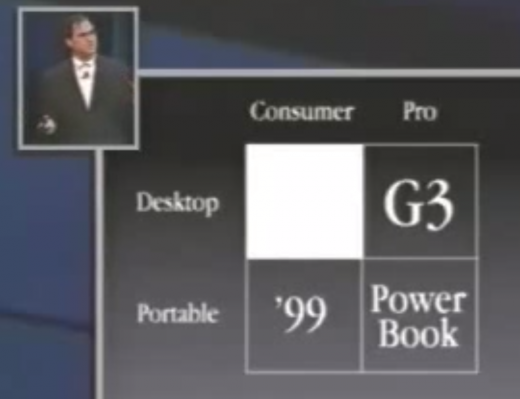
Carl Howe put it this way: Apple makes two types of devices (portable and desktop) for two types of audiences (professional and consumer).
That strategy has continued to this day. The new Mac Pro is a bold re-commitment on Apple’s part to the pro desktop, while the iMac remains its consumer offering. The MacBook Pro serves as its high-end portable, while the MacBook Air is more affordable.
iOS isn’t likely to cannibalize the desktop consumer and pro quadrants anytime soon. “I think the Mac will live on for years as a professional device,” Howe told us.
However, that chart could be recast with iPhones and iPads filling in the portable quadrants. Many iPads are offsetting notebook purchases, and if the rumored iPad Pro comes to pass, it could start to account for professional portable purchases as well.
It’s a mobile world now, and the Mac is living in it. Daniel Kottke, one of Apple’s first employees, said in an interview last week that, when he reflected on the rise of mobile devices, “it’s like the 30th anniversary of the Mac is happening as it’s passing into history.”
“I wouldn’t be surprised to see iOS take over,” he added. “Desktop computing is always going to be required because there’s times when you need to type a lot of stuff, you need more power. But, in general, it’s all going toward mobile: iPhone, iPads, things that we carry with us.”
Next up: A Window to the future | View on one page
A Window to the future
As Cook pointed out, the Mac still has plenty of room for growth even within the shrinking PC market. The future of the Mac is closely linked with the future of Windows. If Microsoft is unable to convince others to buy into its cross-interface vision for Windows 8.1, Apple will have an opportunity to quickly seize market share.
Randy Wigginton, the creator of the original MacWrite program, said in an interview:
I think that with the failure of Windows recently, Microsoft seems very confused about where they want to go, so I think that’s actually helping the Macintosh. Windows took off when the Macintosh had no idea where to go.
Tim Bajarin predicts that PCs will continue to be the workhorse for businesses for at least another decade.
“The actual market for PCs has peaked. We’re not going to see growth years in the 5 percent range ever again, but having said that they’re still an important creation tool in business and education, especially higher education,” he said.
Bajarin added that his firm expects customers in developing markets to use smartphones as a gateway to computing:
Human nature is one that once you start using something like a smartphone or even a cheap tablet, you start saying to yourself, ‘I want more. I want to do this, I want to do that.’ One of the ways I think about the smartphone, is I think they’re training wheels for the next level of computing needs.
Our conclusion through our research is there are a lot of people who have smartphones where that will be their only computing device, but there will be a huge bump of people who have smartphones who want more. The big question to us is, ‘What is ‘more’ going to be?’ We’ve ruled out traditional PCs and laptops, we just think their form factor is not going to drive growth for this next billion users. Instead, we think it’s going to be some form of touchscreen system with larger screens.
There’s nothing stopping such a device from being branded as a Mac, but Apple has so far resisted adding touch functionality to the Mac product line. When asked about combining the interfaces between OS X and iOS, Craig Federighi recently told Macworld:
It’s obvious and easy enough to slap a touchscreen on a piece of hardware, but is that a good experience? We believe, no.
As it stands, it looks like the iPad will drive Apple’s future growth. Most of us grew up on keyboards and mice, so we are most competent on PCs.
However, we are quickly becoming a legacy generation. Today’s kids have cut their teeth, sometimes literally, on touchscreens. When toddlers get their hands on a Mac, they think it’s broken because it doesn’t respond when they touch the screen.

In 10 to 20 years, the touchscreen generation will start to become Apple customers on their own. They’ll be more familiar with virtual keyboards than physical ones, more comfortable with swiping than mouse clicks. Apple could, of course, come up with a new, even better input method, like touchless gestures or thought-controlled interfaces, but if it insists on preserving the keyboard and the mouse, the Mac will be in danger of being relegated to museums and geriatric centers.
For his part, Apple CEO Tim Cook has accepted the fact that the Mac will face some cannibalization from the iPad. Last January, he remarked on the fiscal Q1 2013 earnings call (via Seeking Alpha):
In terms of cannibalization and how we think about this, I see cannibalization as a huge opportunity for us. One, our base philosophy is to never fear cannibalization. If we do, somebody else will just cannibalize it and so we never fear it…We know that iPad will cannibalize some Macs; that doesn’t worry us. On iPad in particular, we have the mother of all opportunities here, because the Windows market is much, much larger than the Mac market is…And as you know, I have said for two or three, actually three years now I believe that I believe the tablet market will be larger than the PC market at some point. And I still believe that.
In order to keep up with consumer’s evolving needs, Apple will need to continue innovating on serving the specialized use cases that the Mac can do better than the iPad, while improving its tablet line so that it better satisfies the mainstream.
I’m probably not in the majority here, but I haven’t owned a desktop PC for over ten years. However, with the advent of the iPad, I’m actually considering moving away from a notebook, switching back to a desktop and relying on a tablet for portability. There are still a couple features, like a windowed multitasking solution, that I need from an iPad to make it feasible for working while traveling or at events, but it’s very close to ideal.
In fact, features like cellular connectivity, longer battery life and the ability to use it while holding in my hands make the iPad better than a MacBook in many situations, assuming that I also have a Bluetooth keyboard on hand for extended typing.
Next up: What’s in a Mac? | View on one page
What’s in a Mac?
In discussing the future of the Mac, it’s worth thinking about what makes a Mac… a Mac.
Reminiscing on the original Mac launch, Howe described the concepts behind it as “breaking the mold” of Apple’s own personal computer experience up to that point.
It was the first computer that was a turnkey device. You brought it home, you plugged it in and you turned it on. It did something. To me, that’s the first thing that comes to mind: the concept that not everyone wants to be a build-it-yourself computer person.
The real legacy [of the Mac] looking into the future is this idea that a computer is not a big ecosystem of piece parts, it’s a self-contained device that has defined interactions with the outside world,” he added. “I think you’ll see new types of products that follow the same mold: neat interface, closed system, works with all of your other stuff, and it’s an appliance, it does something really well.
For Howe, that type of product could be a wearable device, such as a watch or an earpiece for Siri.
“You don’t get there by saying, ‘How do we make a better laptop?’” he said.
While the Mac’s importance to Apple’s bottom line will continue to diminish over time, the originating principles of the Mac: a revolutionary interface, closed system, and consumer-friendly approach, will continue to inform Apple’s future products. The Mac already lives on in the iPhone and the iPad, and its influence will be evident in whatever “new product categories” Apple has cooking for later this year.
Next up: Knowledge Navigator
Knowledge Navigator
Tim Bajarin was seated in the third row of Jobs’ original 1984 Macintosh unveiling.
“[Jobs] was in a double-breasted suit with a bow-tie and this gigantic smile on his face, and with his rather bombastic stage style, he pulled the cover off the Mac and the Mac said, ‘Hello,’” Bajarin recalled.
That presentation is credited as the moment when the graphical user interface and the mouse were introduced to the mainstream, but Bajarin also sees Apple’s Knowledge Navigator concept as the second influential impact that the Mac had on computing.
The Knowledge Navigator video, which was created in 1987 to highlight Apple’s 20-year plan for the Mac, shows a Berkeley professor talking naturally with a virtual assistant on a touchscreen tablet and video chatting with a colleague. The video was set in September 16, 2011. Interestingly enough, Apple had each of the necessary technological components (the iPad, Siri and FaceTime) of the Knowledge Navigator in place by October 2011.
“What [former Apple CEO] John Sculley did with the Knowledge Navigator was he took a lot of the basic principles of desktop computing and the graphical interface and he gave us a vision of the future,” Bajarin said.
Apple didn’t manage to fully realize its 1987 vision for the future, but it did come uncannily close. Today’s natural language processing and artificial intelligence aren’t quite as effective as Knowledge Navigator expected them to be, but the touchscreen, form factor and design have all advanced even farther than anticipated.
Next up: The Mac Pro
The Mac Pro
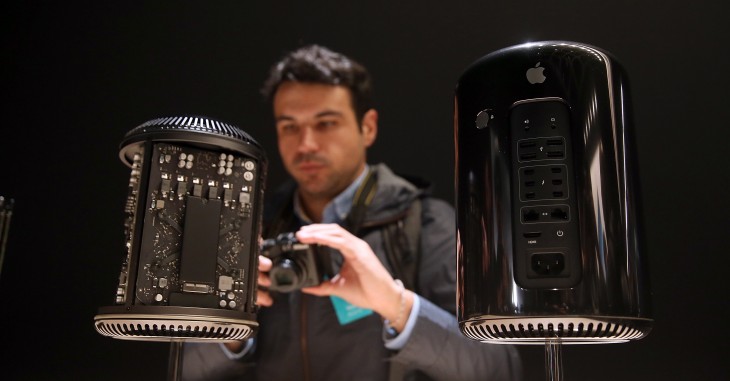
A current discussion of the Mac’s future would be woefully incomplete without discussing the late 2013 Mac Pro. In its 30th anniversary Mac timeline, Apple described the machine as one for “creating the future.”
“The new Mac Pro isn’t just a big leap forward, it’s a huge change in direction. It takes the most advanced technologies available today and puts them together like no computer before it,” the company stated.
Visually, the Mac Pro is the biggest departure since the arrival of the first iMac. It leaves behind over 10 years of design language, trading in angles for curves and silver aluminum for black. Cylindrical MacBooks probably don’t make the most sense, but we’d love to see a Mac notebook in black again.
As the previous generation Mac Pro languished without updates, speculation arose that Apple could actually just kill off the line because of how small the segment is to its overall business. By refreshing the Mac Pro at the end of last year, Apple reaffirmed its commitment to professional-grade desktop computing. The principles behind Apple’s new tower should carry the Mac well into the next decade.
On its product site, Apple says it reconsiderered everything that defines a pro computer: “graphics, storage, expansion, processing power, and memory.”
When I asked what he thought of the new machine, Andy Hertzfeld said he loves it “as a work of art,” while noting that the setup doesn’t quite feel finished because it lacks an Apple-made 4K display to accompany it. 4K will start first with the Mac Pro, but as high-resolution display prices come down, we expect to see a 4K Thunderbolt Display and an Ultra-HD compatible iMac added to the lineup.
The new Mac Pro also represents a shift toward heavier reliance on GPUs, which makes sense given that it’s meant to appeal to graphics and video professionals. The machine packs two AMD FirePro GPUs for double the fun.
Apple has also continued its mission to push the traditional hard-disk drive into obsolescence. Flash storage is still too expensive for the company’s consumer desktops, but pros can spring for the advanced PCIe flash storage on the Mac Pro. It’ll take a while for the technology to make its way to the iMac, though, as a 512GB solid-state drive costs an additional $300 on top of the standard 256GB drive, while 1TB costs a hefty $800 more.
Expandability on the Mac is quickly becoming an external, rather than an internal, affair. Apple set the stage for it when it picked the Thunderbolt standard, and the Mac Pro drives it home. The company doesn’t want you adding much to the inside of its tightly-packed cylinder. Instead, it aims for you to connect peripherals through the Mac Pro’s many ports. With the machine’s six Thunderbolt 2 ports, you can daisy chain up to 36 devices, including three 4K displays.
Apple is also returning to its roots with the Mac Pro by producing it in the US, as it once did with its early computers. While the Mac may be relegated to third fiddle behind iPhone and iPad, its smaller production numbers allow Apple to begin pursuing a Made in America initiative for its desktops.
Next up: Conclusion
Conclusion
As the Mac turns 30, it’s in the best shape it’s ever been in, but the PC industry itself faces an uncertain future. Apple is flush with cash and has a well-oiled leadership team that will help it achieve its future potential. Future Macs will extend deeper into their roles as specialized professional devices as our smartphones and tablets fill most of our everyday personal computing needs.
We think it makes sense for Apple to transition Macs over to the ARM architecture in order to create better vertical synergy with its increasingly important iOS products. I can’t speak directly to the numerous technical challenges that would accompany such a transition, but Apple has proved in the past that it can handle one smoothly with minimal disruption to the end user.
While the Mac branding has remained, the truth is that, in many ways, the iPhone and iPad embody the original spirit of the Macintosh even more so than today’s Macs do. In our conversation with Daniel Kottke, he recalled an early Apple retreat where the company’s vision was to make computers “that you’ll take to bed with you.” Those of us who use our iPhones as alarm clocks and check our notifications as the first thing in the morning and last thing at night know all too well how successful Apple has been.
More than 25 years ago, Apple produced a bold vision of the future with its Knowledge Navigator concepts. Those ideas have come mostly to fruition through products like the iPad, Siri and FaceTime. Calling the iPad the future of the Mac might seem paradoxical, but it’s hard to deny once you’ve compared the latest PC and tablet sales figures. Steve Jobs himself described something like the iPad in 1983 while contemplating the future of the Mac:
Apple’s strategy is really simple. What we want to do is we want to put an incredibly great computer in a book that you can carry around with you and learn how to use in 20 minutes.
Jobs wasn’t the only one to come up with the idea of a book-like computer, but he was certainly one of the few to make it a reality.
In 1996, prior to returning to Apple, Jobs declared:
If I were running Apple, I would milk the Macintosh for all it’s worth–and get busy on the next great thing. The PC wars are over. Done. Microsoft won a long time ago.
He proceeded to do exactly that, first by revitalizing the Mac line with the iMac, and then by creating the iPod, iPhone and iPad.
Apple’s current executives’ insistence that the Mac “keeps going forever” may be overzealous marketing speak, but the innovative spirit of the Macintosh should have no problem continuing well into the future across the Mac, iPhone, iPad and, hopefully, much-anticipated new product categories like wearables.
See also: 30 years in 33 photos: A visual history of the Apple Mac and What to expect from Apple in 2014: A new product category and the beginnings of convergence
Image credits: Justin Sullivan / Getty Images, All About Apple / Wikimedia, Justin Sullivan / Getty Images, peestandingup / YouTube, Justin Sullivan / Getty Images
Get the TNW newsletter
Get the most important tech news in your inbox each week.
